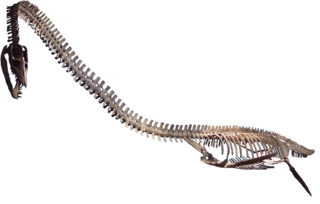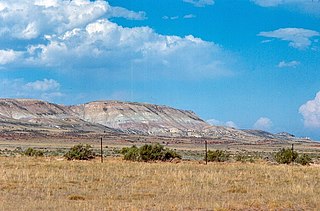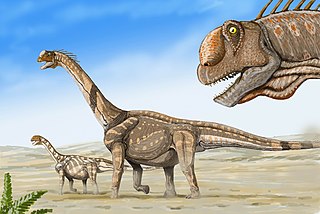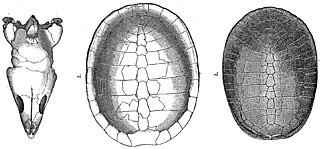
Pteranodon ; from Ancient Greek πτερόν and ἀνόδων is a genus of pterosaur that included some of the largest known flying reptiles, with P. longiceps having a wingspan of over 6 m (20 ft). They lived during the late Cretaceous geological period of North America in present-day Kansas, Nebraska, Wyoming, South Dakota and Alabama. More fossil specimens of Pteranodon have been found than any other pterosaur, with about 1,200 specimens known to science, many of them well preserved with nearly complete skulls and articulated skeletons. It was an important part of the animal community in the Western Interior Seaway.

Meniscoessus is a genus of extinct mammal from the Upper Cretaceous Period of what is now North America. It was a member of the extinct order Multituberculata, lying within the suborder Cimolodonta and family Cimolomyidae.

Othniel Charles Marsh was an American professor of paleontology at Yale College and president of the National Academy of Sciences. He was one of the preeminent scientists in the field of paleontology. Among his legacies are the discovery or description of dozens of new species and theories on the origins of birds.

Camarasaurus was a genus of quadrupedal, herbivorous dinosaurs and is the most common North American sauropod fossil. Its fossil remains have been found in the Morrison Formation, dating to the Late Jurassic epoch, between 155 and 145 million years ago.

Elasmosaurus (;) is a genus of plesiosaur that lived in North America during the Campanian stage of the Late Cretaceous period, about 80.5 million years ago. The first specimen was discovered in 1867 near Fort Wallace, Kansas, US, and was sent to the American paleontologist Edward Drinker Cope, who named it E. platyurus in 1868. The generic name means "thin-plate reptile", and the specific name means "flat-tailed". Cope originally reconstructed the skeleton of Elasmosaurus with the skull at the end of the tail, an error which was made light of by the paleontologist Othniel Charles Marsh, and became part of their "Bone Wars" rivalry. Only one incomplete Elasmosaurus skeleton is definitely known, consisting of a fragmentary skull, the spine, and the pectoral and pelvic girdles, and a single species is recognized today; other species are now considered invalid or have been moved to other genera.

Ichthyornis is an extinct genus of toothy seabird-like ornithuran from the late Cretaceous period of North America. Its fossil remains are known from the chalks of Alberta, Alabama, Kansas, New Mexico, Saskatchewan, and Texas, in strata that were laid down in the Western Interior Seaway during the Turonian through Campanian ages, about 95–83.5 million years ago. Ichthyornis is a common component of the Niobrara Formation fauna, and numerous specimens have been found.

Como Bluff is a long ridge extending east–west, located between the towns of Rock River and Medicine Bow, Wyoming. The ridge is an anticline, formed as a result of compressional geological folding. Three geological formations, the Sundance, the Morrison, and the Cloverly Formations, containing fossil remains from the Late Jurassic of the Mesozoic Era are exposed.

Agathaumas is a dubious genus of a large ceratopsid dinosaur that lived in Wyoming during the Late Cretaceous. The name comes from Ancient Greek: αγαν - 'much' and θαυμα - 'wonder'. It is estimated to have been 9 metres (30 ft) long and weighed 6 tonnes, and was seen as the largest land animal known at the time of its discovery.

Zapsalis is a genus of dromaeosaurine theropod dinosaurs. It is a tooth taxon, often considered dubious because of the fragmentary nature of the fossils, which include teeth but no other remains.

Nanosaurus is the name given to a genus of neornithischian dinosaur that lived about 155 to 148 million years ago, during the Late Jurassic-age. Its fossils are known from the Morrison Formation of the south-western United States. The type and only species, Nanosaurus agilis, was described and named by Othniel Charles Marsh in 1877. The taxon has a complicated taxonomic history, largely the work of Marsh and Peter M. Galton, involving the genera Laosaurus, Hallopus, Drinker, Othnielia, and Othnielosaurus, the latter three now being considered to be synonyms of Nanosaurus. It had historically been classified as a hypsilophodont or fabrosaur, types of generalized small bipedal herbivore, but more recent research has abandoned these groupings as paraphyletic and Nanosaurus is today considered a basal member of Neornithischia.
Dysganus (dis-GANN-us) is a dubious genus of ceratopsian dinosaur from the Campanian stage of the Late Cretaceous. The fossil teeth referred to Dysganus were first collected by Charles Sternberg from the Cretaceous Judith River Formation of Montana and later described by Edward Drinker Cope. All of the species are now seen as dubious Ceratopsians, though referred material from tyrannosaurids and hadrosaurids were found in New Mexico.

Dystrophaeus is the name given to an extinct genus of eusauropod dinosaur from the early Kimmeridgian stage of the Late Jurassic that existed around 154.8 Ma. Its fossils were found in the Tidwell Member of the Morrison Formation of Utah. It was a relatively medium-sized sauropod, reaching 13 m (43 ft) in length and 7–12 metric tons in body mass.

Protosphyraena is a fossil genus of swordfish-like marine fish, that thrived worldwide during the Upper Cretaceous Period (Coniacian-Maastrichtian). Though fossil remains of this taxon have been found in both Europe and Asia, it is perhaps best known from the Smoky Hill Member of the Niobrara Chalk Formation of Kansas. Protosphyraena was a large fish, averaging 2–3 metres in length. Protosphyraena shared the Cretaceous oceans with aquatic reptiles, such as mosasaurs and plesiosaurs, as well as with many other species of extinct predatory fish. The name Protosphyraena is a combination of the Greek word protos ("early") plus Sphyraena, the genus name for barracuda, as paleontologists initially mistook Protosphyraena for an ancestral barracuda. Recent research shows that the genus Protosphyraena is not at all related to the true swordfish-family Xiphiidae, but belongs to the extinct family Pachycormidae.

Protostega is an extinct genus of sea turtle containing a single species, Protostega gigas. Its fossil remains have been found in the Smoky Hill Chalk formation of western Kansas, time-equivalent beds of the Mooreville Chalk Formation of Alabama and Campanian beds of the Rybushka Formation. Fossil specimens of this species were first collected in 1871, and named by Edward Drinker Cope in 1872. With a total length of 3.9 metres (13 ft), it is the second-largest sea turtle that ever lived, second only to the giant Archelon, and one of the three largest turtle of all time along Archelon and Gigantatypus.

Benjamin Franklin Mudge was an American lawyer, geologist and teacher. Briefly the mayor of Lynn, Massachusetts, he later moved to Kansas where he was appointed the first State Geologist. He led the first geological survey of the state in 1864, and published the first book on the geology of Kansas. He lectured extensively, and was department chair at the Kansas State Agricultural College.

Camarasaurus supremus is a species of sauropod dinosaur that lived during the Jurassic period in what is now the western United States. It is the type species of Camarasaurus, which also includes the species Camarasaurus grandis, Camarasaurus lentus, and Camarasaurus lewisi. C. supremus was discovered by the paleontologist Edward Drinker Cope in 1877, at the outset of the Bone Wars, a period of scientific competition between Cope and his rival Othniel Marsh. C. supremus is the largest and geologically youngest species in its genus, and was contemporary with several other exceptionally large dinosaurs, such as Saurophaganax and Maraapunisaurus. Despite being the first discovered species of Camarasaurus, C. supremus is relatively rare and poorly known.

Pachyrhizodus is an extinct genus of ray-finned fish that lived during the Cretaceous to Paleocene in what is now Europe, North America, South America, and Oceania. Many species are known, primarily from the Cretaceous of England and the midwestern United States.

Glyptops is an extinct genus of pleurosternid freshwater turtle known from the Late Jurassic of North America.

Amphicotylus is an extinct genus of goniopholidid mesoeucrocodylian from the Tithonian of Colorado, Wyoming, and Oklahoma. It was described in 1878.

Pteranodontoidea is an extinct clade of ornithocheiroid pterosaurs from the Early to Late Cretaceous of Asia, Africa, Europe, North America and South America. It was named by Alexander Wilhelm Armin Kellner in 1996. In 2003, Kellner defined the clade as a node-based taxon consisting of the last common ancestor of Anhanguera, Pteranodon and all its descendants. The clade Ornithocheiroidea is sometimes considered to be the senior synonym of Pteranodontoidea, however it depends on its definition. Brian Andres in his analyses, converts Ornithocheiroidea using the definition of Kellner (2003) to avoid this synonymy.





















